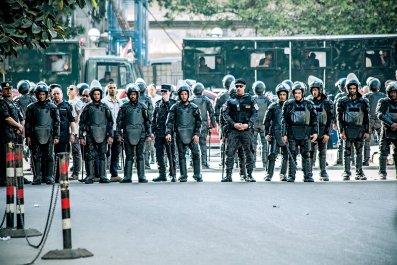Updated | In their techno-thriller Ghost Fleet, authors Peter Singer and August Cole describe a cataclysmic world war that begins with a Chinese sneak attack against the U.S. in space. First, soldiers at China's Cyber Command Headquarters in Shanghai hack into the Pentagon's network of GPS satellites and scramble their signals. The cyberattack sows chaos among U.S. forces, which can no longer navigate accurately, track targets or hit them with precision munitions.
Then, from a space station orbiting 200 miles above Earth, Chinese astronauts train a laser gun on three dozen U.S. satellites the military relies upon for virtually all of its communications and critical surveillance. By the time the Chinese are done, America's technological edge on this new, 21st-century battlefield has been reduced to the predigital levels of World War II.
Such scenarios may read like science fiction, but the threat of what military experts call a "space Pearl Harbor"—a sneak attack on U.S. satellites that cripples American forces before a shot has been fired—has Pentagon planners seriously worried. Space is the ultimate high ground for today's warriors, and no military has dominated those strategic heights as successfully as America's. But its constellations of GPS, surveillance and communications satellites are largely undefended, a vulnerability that hasn't escaped notice in China and Russia. The result: a new three-way space race—the first since the end of the Cold War, and one that now includes the development of weapons to knock out the other side's space assets.
"The U.S., China, Russia are all working on not just using space but also taking it away from the other side," Singer, a military strategist at the New America Foundation, a Washington, D.C., think tank, tells Newsweek.
Chinese President Xi Jinping paid a high-profile visit last month to air force headquarters in Beijing, where he ordered his generals to sharpen the country's defensive and offensive capabilities in space in preparation for what many Chinese military analysts believe is an inevitable war in space with the U.S. Like the U.S. and Russia, China has sent astronauts into space and landed a spacecraft on the moon, and it is developing its own space station. The Pentagon also notes that Beijing continues to ramp up its military capabilities in space, launching 142 satellites to provide intelligence, navigation, communications and weather forecasting that can "limit or prevent the use of space-based assets by adversaries during times of crisis or conflict."
A war in space would have staggering implications. If conflict were to erupt, say, over China's territorial claims to the South China Sea or Russia's aggression in Eastern Europe, America's military satellites wouldn't be the only space assets at risk. Fighting would also likely cripple the civilian satellites that control so much of modern life, from cellphone networks to ATMs and personal GPS units. And although such a conflict might start in space, experts say it could easily turn into full-scale war on Earth. "If war does extend into space someday—and I hope it never does—the first [nuclear] response is not going to be in space," warns General John Hyten, head of the U.S. Air Force Space Command.
This year, the Pentagon will spend $2 billion on measures to counter threats to its national security satellites. That amount is expected to soar as part of the $22 billion set aside to maintain U.S. superiority in space in 2017. Senior U.S. officials explain such large investments reflect the Pentagon's recognition of a major shift in U.S., Chinese and Russian capabilities. For the first 25 years after the Cold War's end, they note, America's conventional forces were unmatched, thanks largely to the advantages their satellites gave them on the battlefield. Making their debut in the 1991 Persian Gulf war, satellites have guided American precision munitions, provided U.S. commanders with worldwide communications and helped American forces navigate the globe ever since.
But over the past 15 years, a period in which U.S. defense dollars were diverted to pay for the wars in the Middle East, China and Russia have developed advanced weapons that "challenge our advantages...especially in cyber, electronic warfare and space," says Deputy Defense Secretary Robert Work. "As a result, our margin of technological superiority is slowly eroding."
Today, Beijing and Moscow can no longer be ignored. With their ability to deny, disrupt and degrade America's hard-to-defend satellites, warns Lieutenant General David Buck, commander of the 14th Air Force, "there isn't a single aspect of our space architecture that isn't at risk."
Missiles, Lasers and Space Bots
Last December, the U.S. Air Force Space Command in Colorado Springs held a large-scale war game set in outer space in 2025. Some 200 U.S. military and civilian experts, as well as representatives from Britain, Canada, Australia and New Zealand, took part. The details remain highly classified, as does the U.S. military's arsenal of space weapons. But the Space Command said the exercise "included full-spectrum threats across diverse operating environments." Translation: The participants had to deal with all the known dangers to U.S. satellites, plus a few that are suspected to exist.
The known threats include Chinese ballistic missiles that can hit U.S. satellites in low Earth orbit about 500 miles up and possibly those in high geostationary orbits some 22,000 miles above the Earth. China and Russia also have ground-based lasers that can blind the camera on a reconnaissance satellite or burn up the spacecraft altogether, and experts say spacecraft-mounted lasers are just a few years away. Moscow and Beijing are also believed to be developing satellites that can disable, bump off course or destroy other satellites.
Any combat in space also would involve cyberattacks like the one in 2011, when a Romanian hacker gained access to NASA's confidential satellite data. Three years later, U.S. officials say, China hacked the satellite network of the National Oceanographic and Atmospheric Administration, the nation's weather forecaster, forcing it to shut down for two days. The penetration exposed a dangerous vulnerability: In a scenario similar to the one Singer and Cole describe in their novel, hackers could reprogram a U.S. satellite to send false weather reports, coordinates and other disinformation to American and allied forces, throwing off planning, navigation and targeting. Singer, who serves as a consultant to the Air Force Space Command and the U.S. intelligence community, says satellite hackers could even redirect a U.S. missile to strike its own forces or alter the course of the satellite.
This isn't the first time that military planners have worried about the threat of war in space. In the years following the Soviet Union's 1957 launch of Sputnik, the first man-made satellite, the U.S., fearing a Soviet nuclear attack from space, began exploring ways to shoot down satellites. The U.S. military also conducted a series of nuclear tests in space. One, carried out some 250 miles above the South Pacific in 1962 , generated an electromagnetic pulse so powerful that it fried the electronics of five U.S. satellites and caused power, telephone and radio blackouts thousands of miles away. The tests were stopped in 1967 under the U.N.'s Outer Space Treaty, which banned placing weapons of mass destruction in space.

For the remainder of the Cold War, powerful surveillance satellites became the key component in U.S. and Soviet early-warning systems to detect preparations for a nuclear test or a missile launch. But that didn't stop the rival superpowers from figuring out ways to grab an advantage in space. The Soviets developed the space equivalent of a suicide car bomb—an unmanned vehicle that could sidle up to an orbiting U.S. satellite and then blow up beside it. In the 1980s, President Ronald Reagan launched his multibillion-dollar Strategic Defense Initiative, derisively nicknamed Star Wars, which called for a combination of ground-based interceptors and space-based lasers to shield the United States from a Soviet nuclear ballistic missile attack. In 1985, Reagan demonstrated U.S. prowess when an Air Force F-15 fighter flying at 38,000 feet launched a missile that destroyed a faltering U.S. satellite.
Yet the U.S. and Soviet Union never fought in space. That's because each side knew the other regarded its early-warning satellites as a critical component of its nuclear arsenal, U.S. officials say. Any strike against the other's satellites would be seen as the opening shot in a nuclear attack, triggering immediate nuclear retaliation. "Both we and the Soviets understood the red lines in terms of attacks on space systems that we dared not cross," says Work, the deputy defense secretary.
But after the end of the Cold War, in 1991, the situation in space grew far more complicated. Some 60 other countries eventually joined the U.S. and Russia in space, contributing to a wreath of an estimated 1,100 satellites circling the globe. Meanwhile, U.S. forces became ever more dependent on their satellites—not only for nuclear early warning but also for conventional military requirements such as communications, weather reports and navigation. The Pentagon, however, spent little time thinking about how to protect them. The military leaders of the world's sole superpower came to regard space as an American sanctuary, and both personnel and budgets were shifted to other priorities. "Our adversaries noticed all that," says Singer.
Surviving an Attack
Suspicions that China was developing anti-satellite weapons arose in January 2007, when Beijing fired a missile that hit one of its own aging weather satellites in low Earth orbit. Then, in 2013, China tested a missile that climbed to 18,000 miles—high enough to take out U.S. GPS satellites and nearly reaching the military's early-warning satellites that hang in geostationary orbit 22,000 miles above the Earth. China is believed to have conducted similar tests in 2010, 2014 and 2015, leading Pentagon planners to conclude it will deploy these missiles, placing U.S. space systems under constant threat. "You don't have a seven-year development plan if you're not going to make it operational," Hyten, the Air Force Space Command chief, said last year.
Meanwhile, lingering suspicions about Russia's newest space weapons center on its launch of four military satellites in 2013 and 2014. According to Brian Weeden, a former Air Force captain specializing in space surveillance, three of the satellites have changed orbit several times. They moved close to a Russian spacecraft and even collided with it. The fourth satellite maneuvered close to several newly launched Russian satellites and came very close to two Intelsat commercial communications satellites. "The technology could be used for ASATs," Weeden tells Newsweek, using the military abreviation for anti-satellite weapons. But he adds it's not clear that the Russians were conducting ASAT tests.
U.S. military planners are now debating how to protect the country's military satellites and maintain the flow of information from space if some of those satellites are taken out in a conflict. The Pentagon is stressing the idea of resiliency, broadening the use of defenses already on some of the military's latest satellites. They range from adding a thick shutter to a spy satellite's camera for protection against a laser attack to boosting a satellite's signals to prevent jamming. Other methods include frequency hopping, which enables satellites to transmit data on alternative frequencies if some are jammed. The military also has diversified its information sources by acquiring data from neutral countries and commercial satellites.
Military officials are now seeking alternatives to GPS navigation. They're also taking a hard look at two multibillion-dollar programs for satellites that are critical for the country's strategic nuclear defenses but also sport conventional communications and surveillance capabilities. Such add-ons became commonplace back when space was uncontested and the military's main concern was getting the most bang for its buck with each expensive satellite launch. But with these multitasking satellites presenting such juicy targets to U.S. adversaries, Pentagon officials say, it might make more sense to spread their capabilities around on smaller, less expensive satellites—an approach they call disaggregation.
"The changing nature of the threats in space, namely anti-satellite weapons and jammers being developed by countries such as China and Russia, are driving some of the thinking," Frank Kendall, the Pentagon's top weapons buyer, told a Washington gathering of space businesspeople in February.
As the Pentagon explores new ways to protect its satellites, America's fallback policy remains deterrence by threat of retaliation. Depending on which satellites are attacked, the U.S. could confine itself to taking out the enemy's equivalent satellites. But if China or Russia destroyed the Pentagon's nuclear early-warning and strategic communications satellites, military strategists say, it's unlikely the U.S. response would stay in space.
"We would interpret such an attack as going to war against us," says Singer. Under this scenario, commercial satellites, along with the Earth's space-based civilian infrastructure, would probably be destroyed. "War in space would very quickly involve the civilian world," he says.
Such scenes play out in Ghost Fleet, which is now required reading for military planners in the U.S. Space Command, as well as in the Army, Navy, Marines and CIA. Singer recently testified before Congress and briefed White House National Security Council staff on the real-world lessons of his thriller, which contains 400 footnotes based on the space weaponry and battle plans of the United States, China and Russia. "It's a novel, but it's a realistic look at how a war might play out when we lose the opening battle in space," Singer says, adding: "Let's hope it stays in the realm of fiction."
Correction: This article originally incorrectly cited former U.S. Air Force Captain Brian Weeden as saying that Russia conducted anti-satellite weapons tests in 2013 and 2014. Weeden says the technology demonstrated in those tests could be used in anti-satellite weapons, but it's not certain the purpose of those tests was to demonstrate Russia's anti-satellite capabilities.
















